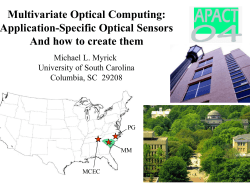
FFPI 1502 copy - Micron Optics
Fiber Fabry-Perot Interferometer | FFP-I Description Key Features Micron Optics’ FFP-I, Fiber Fabry-Perot Interferometer family of products is based on a fixed interferometer design with smooth, uniformly spaced transmission peaks. Spectrum Sliced Source FFPI Laser Stabilization The FFP-I consists of a lensless, plane Fabry-Perot Interferometer with a single-mode optical fiber waveguide between two highly reflective multilayer mirrors. The FFP-I is manufactured directly with optical fibers so no alignment or mode-matching is required. The free spectral range (FSR) may be manufactured exactly to customer specifications and a TEC package is available for thermal stability and minor adjustments of center bandpass frequency. WDM Emulation ITU Filter Calibrated Wavelength Reference Optical Sensing A smooth, uniformly spaced λ reference with or without a wavelength marker. picoWave® The picoWave® is Micron Optics’ patented multi-wavelength reference that enables real time wavelength calibration to picometer accuracy. Combining the uniform frequency spacing of the FFP-I, a wavelength marker of a Fiber Bragg Grating, and a built-in TEC for thermal stability, the picoWave® makes an ideal calibrated wavelength reference. The FFP-I and FBG can be configured in Series or in Parallel (see diagrams below). OEM Applications Optical Performance Monitoring Spectrum Analysis Tunable Optical Noise Filtering Tunable Channel Drop for Ultra DWDM Tunable Sources Optical Sensing Fiber Fabry-Perot Interferometer | FFP-I Special OEM Options Optical Properties picoWave® FFP-I Operating wavelength range1 Finesse Wavelength Range: 780 - 1640 nm 1260 - 1620 nm Free spectral range 0.01 to 10,000 GHz 10 - 100 GHz 10, 40, 100, 200, 500, 1000, 2000 10 Bandwidth, (FWHM or 3dB) 100 mW (for finesse < 200) Thermal Coefficient Wavelength marker placement Bandwidth: from KHz to GHz Ordering Information < 3 dB Maximum input power3 Finesse: up to 4,000 ITU Tolerance: from 0.5 to 0.05% FSR/Finesse Insertion loss2 Contact Micron Optics FFP-I wwww - bbb u ffff - ii - ccc ~ 1.6 GHz/C n/a n/a User defined wwww Electrical Properties (optional for FFP-I with FSR > 10 GHz, standard for picoWave®) TEC Melcor Epoxy Filled 04OT2.0-30-F2-EP TEC drive current <2A TEC Qmax (TH= 25 °C) <4W TEC Vmax (TH= 25 °C) < 3.4 V TEC ΔTmax (TH= 25 °C) 67 C Thermistor 10 ΚΩ NTC Thermal tuning speed +/- 0.125 GHz, laboratory conditions FSR variation over tuning range (1260-1360 nm) (1520-1570 nm) (1360-1480 nm) (1570-1620 nm) (1480-1520 nm) (1520-1620 nm) Specify bandwidth For example, 040 = 40 GHz bbb Bandwidth unit G GHz M MHz K KHz u Specify finesse For example, 0650 = finesse of 650 ffff Specify insertion loss For example, 2.5 = 2.5 dB loss ii 1 GHz/sec, typical Stability 1310 1550 1420 1600 1500 1580 061 063 065 ccc 0.05% of FSR Unconnectorized FC/APC (fusion spliced) SC/APC (fusion spliced) FC/APC (connectorized) Notes 1 Each useful spectral range defined by mirror pass band. High resolution (BW <2 GHz) FFP-Is are generally polarization sensitive. However, polarization properties are 2 stable and can be adjusted by a polarization controller at the FFP-I input. 3 Maximum input power level depends on finesse value. 1852 Century Place NE Atlanta, GA 30345 USA www.micronoptics.com Copyright © 2015, FFP-I-1502. All rights reserved. Specifications subject to change without further notice.
© Copyright 2025





















